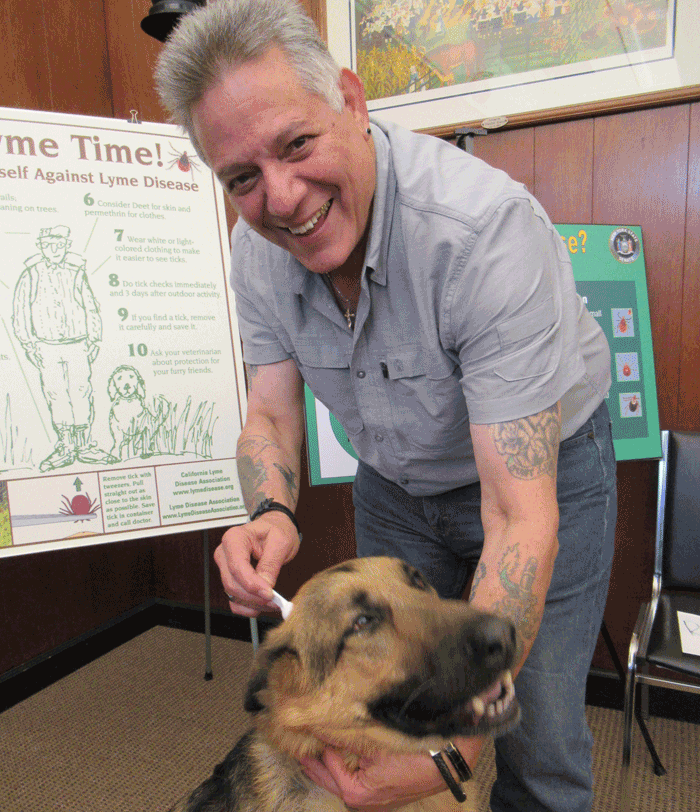PUTNAM VALLEY – The incidence of Lyme disease and other tick-borne illnesses is frightening since more than 400,000 new cases of Lyme have been reported across the United States with 98,000 cases confirmed in New York State.
State Senator Susan Serino (R, Hyde Park) and Putnam Valley Supervisor Sam Oliverio recently hosted a forum at Putnam Valley Town Hall dubbed “Tick Talk” where for nearly two hours experts in the field raised awareness while relaying the seriousness of a tick bite to an audience of some 75 men and women.
Serino called on the public to remain “vigilant when enjoying the out-of-doors. “Awareness is the key to prevention. By becoming attentive we can ensure that residents have information needed to stay safe, healthy and tick-free.”
Oliverio knows firsthand the devastating effects a tick bite can have because the retired educator and veteran political leader is lucky to be alive.
Members in the audience sat on the edge of their seats when the life-long Putnam Valley resident told his tale that began when he was bitten by a tick in June.
Oliverio removed the insect and thought nothing of it since there was no bull’s eye or rash in the vicinity of the bite.
While on vacation in South Dakota days later, the supervisor began feeling ill. “I wasn’t in pain. I just felt like my body weighed 40 million tons. I couldn’t move. I began experiencing chills, hot flashes and some disorientation along with difficulty in breathing. The local hospital’s emergency room in South Dakota was my next stop and a physician attributed my condition of malaise and discomfort to the difference in altitude of Putnam County as compared to the Dakotas where mountain ranges are as high as 6,000 feet,” he said.
Tests were taken but everything came out negative. “I was told to ‘go slow and drink a lot of fluids.’”
When Oliverio returned to Putnam Valley the following week he continued to “feel lousy. I suffered from lethargy, joint pain and a general feeling of being out-of-it. I came to work, nevertheless, but each day grew progressively worse.”
The ‘end’ almost came when Oliverio awakened in the middle of the night on July 3 and “I felt as though I was having a heart attack. I awakened my lady friend advising ‘you have to get me to the emergency room’.”
While en route to Hudson Valley Hospital Center, Oliverio passed out in the car and the “next thing I knew was waking up in the ER with seven people around me. I asked, ‘What’s going on?’ I was advised, ‘We are trying to keep you alive!’ My blood pressure dropped to 50 over 30. My kidneys had failed and my heart went into atrial fibrillation. I was bad! Nineteen vials of blood were taken and I was hooked up to six different medication drips. Two-and-one-half gallons of fluids were pumped into my body, or 20 pounds of water weight.”
An emergency room physician diagnosed the problem asking. “Have you been bitten by a tick recently? Tests indicated I had a severe case of Ehrlichiosis, a nasty tick borne disease. I never realized how devastating and serious a tick bite could be. It almost killed me.”
Oliverio received large doses of Doxycycline and is now in good health.
“My only regret is that I originally failed to listen to my body which was screaming ‘something is wrong.’ If I had listened and been hospitalized before my vacation, I would not have experienced that slow dance with death,” he said.
Matt Frye, a professor at Cornell University, debunked a number of tick myths during the forum. “It’s false to believe that only outdoorsy people are bitten by ticks. It’s false to believe that mid-spring through summer is the riskiest season for getting a tick-borne disease. A bull’s eye rash does not always appear with Lyme disease. The blacklegged tick is the only one that can transit Lyme disease. Children aged five through nine have the highest incidence of Lyme.”
Holly Ahern, an associate professor of Microbiology at SUNY Adirondack, told the audience that there was “no reliable way to diagnose Lyme since diagnostic tests for Lyme are not clinically accurate. Of the more than 400,000 cases confirmed across the country, 240,000 of the victims will develop a chronic illness. By the year 2022, 1.2 million cases will have been confirmed. What is so frightening is that there is no effective treatment for patients with chronic symptoms.”
Cassandra Guarino, an associate for Immunology at Cornell University College of Veterinary Medicine, discussed Lyme and pets, calling it “imperative that owners of dogs and horses check them daily for ticks and don’t forget to have them inoculated against Lyme.”
Symptoms included Fido limping, running a fever while becoming anorexic, lethargic that can eventually lead to renal failure.
Guarino said cats were not “typically susceptible to Lyme but cats are susceptible to other tick borne disease.”
She also reminded those in attendance to “never place a tick or flea collar sold for a dog on a cat. It can kill the feline.”
Jill Auerbach, chairwoman of the Hudson Valley Lyme Disease Association, reported that Lyme was found in 50 percent of all counties across America yet “nothing is being done to stop the tick.”
She explained how to safely remove a tick attached to the skin. “Don’t panic. Grasp the tick near its head with a pair of fine point tweezers and pull it away gently removing the whole tick without crushing it.”
Auerbach also instructed the audience how to prevent ticks from biting. “Wear long pants and long sleeved shirts and tuck the legs into socks or boots. Wear light colored and tightly woven clothing. Purchase clothing pre-treated with Permethrin which will last up to 70 washes as compared to only seven washes if you ‘do it yourself’ by using the repellent and others such as DEET.”
Serino called on those who desire to see funding to combat Lyme and other tick borne diseases in next year’s state budget to sign her online petition. “We must continue the fight against disease bearing insects,” she said.








